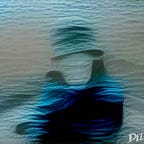I KNOW — On the aesthetic of truth
Exhibition organized by Feral File and synthesis gallery
In our world, where misinformation, disinformation and media hyperbole reign supreme, it is often necessary to ask ourselves what is true and what is not. The answers we seek, which may seem simple at first glance, are by no means obvious. We live hectic lives in an environment dominated by technology of which we often become unaware victims, where by now the physical and the digital are increasingly lost in each other changing the perception of what surrounds us. A theme dear to philosophy and history, the search for truth is a tortuous journey where there is no black or white as mutual exclusions, but many shades of gray that are built on the complexity of reality.
I KNOW (2022), an exhibition curated by art advisor and gallery owner Giorgio Vitale, investigates the Post-Truth era through the heterogeneous work of an inter-generational group of artists. The show, which has a physical presence in Berlin through Vitale’s synthesis gallery and an online one on the platform Feral File, is also part of the NFT Biennial and Vorspiel ’23 organized by Transmediale. The title of the show takes its cue from the J’accuse by Italian writer, intellectual, poet, and filmmaker Pier Paolo Pasolini who in the 1970s railed against the homogenization of consumerist society. Through the language of the absurd, I KNOW invokes the aesthetic experience as a tool to investigate the truth and restore art to its leading role in society. The exhibition reflects the different aesthetics and strategies of the artists, offering a wide range of themes that develop from the past and unfold in the near future: art offers a window on the possible, on what can be but is not yet.
“The Art of Survival: Aphorisms by an Old Girl” (2020 -2023) by Claudia Hart draws inspiration from the classic canons of power politics. Influenced by the work of Machiavelli and Sun Tzu, the NFT collection is interpreted by the bot of Her Majesty, the late Queen Elizabeth II. Hart’s aphorisms are composed as a series of homilies which, in their unity, give life to a public speech to convey comfort and healing in a world torn apart by polarization.
In “Turandot 2070”, the most recent large-scale multi-channel video installation by AES+F, the main topic dealt with is that of the confusion and vulnerability of the masses in the face of a techno-matriarchal government that trains them to tolerate violence in its various forms. By hiding her identity behind ever-changing avatars, Turandot’s brainwashing program continues quite undisturbed. In the collective memory, space is thus made for scandals and amplifications on various themes, such as for example #cancelculture or #metoo. The works shown in I KNOW carry forward the collective’s interest in exploring obessions, virtues and vices of contemporary global culture.
The work showcased by media artist, activist and programmer aaajiao is provocative and investigates both our relationship with the nascent Web3 (“Unzip”) and many phenomena that concern the Internet (“Prophecy, nullification algorithm, shaman, conspiracy”), such as data processing, algorithmic dominance or the blogosphere. aaajiao’s attention is focused on the behavior of the new generations who seem to eagerly consume technology.
Korean-born web artist Yehwan Song re-proposes the theme of the neutrality of technology by contrasting the excessive consistency of web interfaces with a work that sabotages both the rules of web design and the so-called friendly user experience. “Artwork 1 & 2” create a parody of the functioning of touch screen sensors to investigate the dynamics of power that lie behind the formal use of technology and its understanding. The website-based sculptures continue to mutate, highlighting how the lack of belonging in the design of technology can cause serious damage to excluded groups.
The works of artist Cibelle Cavalli Bastos, which fit into their ongoing research on appearance, perception and the multiple faces of collectivity and individuality, leverage on artificial intelligence (AI). “A Picture Can’t Take Me” and “A Picture Can’t Take My Elan Vital” want to show the impossibility of capturing portrait subjectivity. The video-audio works are based on the combined use of the GPT2 pre-trained language model and on the generative output produced by the StyleGAN2 generative adversarial network. For both the works, the dataset was created using a collection of images taken from the artist’s Instagram account and Google image search. Bastos’ work challenges the oppressive domain of algorithms to obtain intermediate spaces to be dedicated to new forms of being.
I KNOW is an exhibition that develops different themes united by a strong cultural and social imprint. The aim is to entice the visitor to reflect on the complexity of reality and on the very concept of truth which, seen in the light of an increasingly pervasive technology, can be difficult to bring out. Works can be purchased on the platform Feral File.
